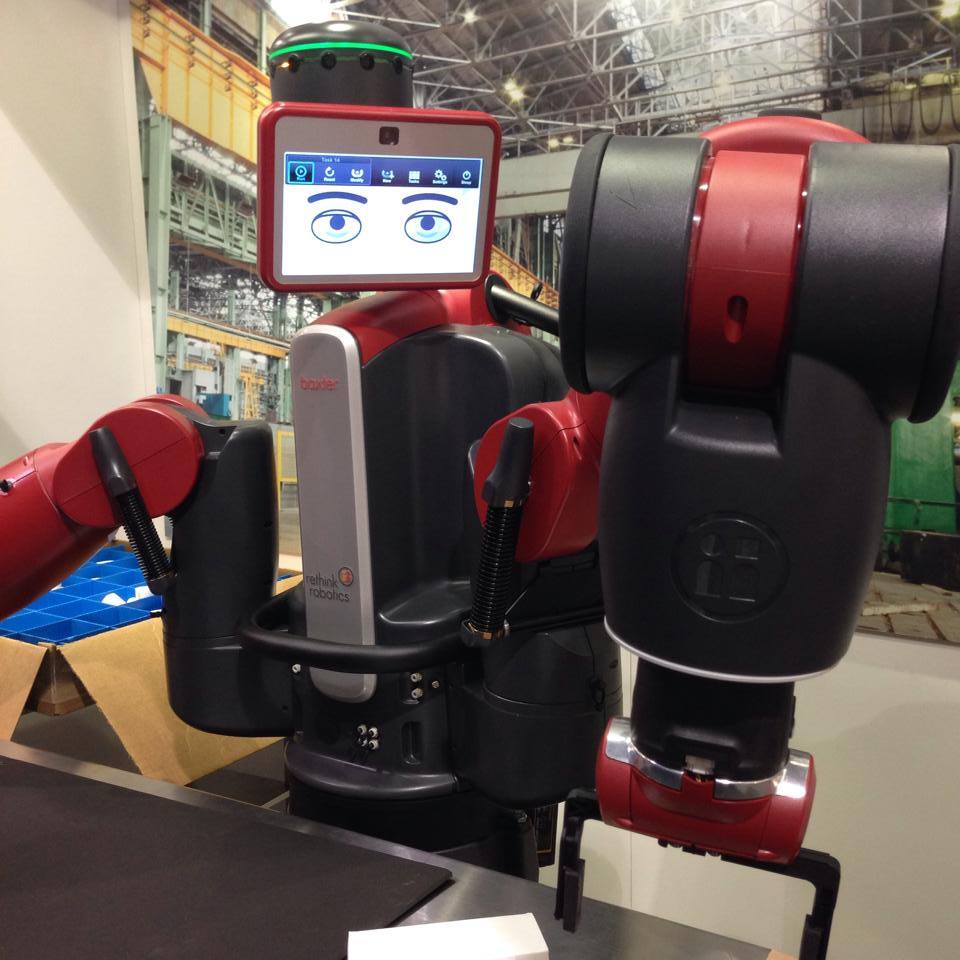



Anaheim Event Series Day 1 - Rise of the Machines
Arranged by UBM Canon, and featuring 8 co-located shows - Medical Design & Manufacturing, Pacific Design & Manufacturing, Automation Technology, AeroDefense Con, PlasTEC, West PACK, Electronics West, and Sustainability in Manufacturing - today's event series in Anaheim, CA showed us the future of manufacturing and automation.
Today most of our time was spent exploring the West PACK, Electronics, Pacific Design & Manufacturing, and Automation Technology sections of the show encompassing all 1.6 million square feet of the Anaheim Convention center. While the show can be somewhat overwhelming, two main things stood out - the implementation and integration of affordable robotics and the continued rise of 3D printing used in rapid prototyping and low volume production.
The Personal Robot
 One of my personal favorites from the day was Redefining Robotics' Baxter collaborative robot. Originally used for pick-and-place processes, Baxter has recently received a software update - just like your personal computer - that expands his abilities to include more intricate trained movements.
One of my personal favorites from the day was Redefining Robotics' Baxter collaborative robot. Originally used for pick-and-place processes, Baxter has recently received a software update - just like your personal computer - that expands his abilities to include more intricate trained movements.
The key word there is trained. Baxter doesn't require any specialized programming, the trainer simply grasps his wrist and guides his elbow while each movement and stop point is recorded - or learned. The benefits to this are obviously that it does not require any advanced programming knowledge, and can even be trained by the individuals currently working on the production line.
Baxter is a collaborative robot and meant to work alongside your current workers - not to replace them fully. He was designed to work side-by-side with people and has what the manufacturer describes as a 'passive safety system' meaning that he is safe even in adverse conditions, such as a power outage.
The most noticeable feature of Baxter is the fact that while in operation his screen features two eyes with emotive eyebrows that help telegraph what the robot is experiencing. You see a passive relaxed face when the trained motions are working as expected, but if something happens - no more parts or something in his way for example - the eyes show visible concern and the face will turn to look at the arm experiencing the issue.
At a price point that is roughly equal to a year's salary for an employee, Baxter is an emerging and exciting technology that we could see becoming more and more prevalent in the coming years.
3D Printing
One of the most prevalent and eye-catching exhibitor types we saw while walking the show today were 3D printing companies. If you're not familiar with 3D printers, they are able to create three dimensional products by "printing" thin layers of molten polymer one on top of the other. One of the biggest applications for this is through rapid prototyping. Imagine being able to create a lightweight replica of a piece before investing in expensive tooling or machining.
One of the best parts of 3D printing is that the initial investment is relatively low with small 3D printers averaging about $3,000.
We're sure to see these trends continue tomorrow as we explore the rest of the show. The amount of innovation in one building was inspiring, and we're looking forward to seeing what tomorrow has to offer!
Today most of our time was spent exploring the West PACK, Electronics, Pacific Design & Manufacturing, and Automation Technology sections of the show encompassing all 1.6 million square feet of the Anaheim Convention center. While the show can be somewhat overwhelming, two main things stood out - the implementation and integration of affordable robotics and the continued rise of 3D printing used in rapid prototyping and low volume production.
The Personal Robot
 One of my personal favorites from the day was Redefining Robotics' Baxter collaborative robot. Originally used for pick-and-place processes, Baxter has recently received a software update - just like your personal computer - that expands his abilities to include more intricate trained movements.
One of my personal favorites from the day was Redefining Robotics' Baxter collaborative robot. Originally used for pick-and-place processes, Baxter has recently received a software update - just like your personal computer - that expands his abilities to include more intricate trained movements. The key word there is trained. Baxter doesn't require any specialized programming, the trainer simply grasps his wrist and guides his elbow while each movement and stop point is recorded - or learned. The benefits to this are obviously that it does not require any advanced programming knowledge, and can even be trained by the individuals currently working on the production line.
Baxter is a collaborative robot and meant to work alongside your current workers - not to replace them fully. He was designed to work side-by-side with people and has what the manufacturer describes as a 'passive safety system' meaning that he is safe even in adverse conditions, such as a power outage.
The most noticeable feature of Baxter is the fact that while in operation his screen features two eyes with emotive eyebrows that help telegraph what the robot is experiencing. You see a passive relaxed face when the trained motions are working as expected, but if something happens - no more parts or something in his way for example - the eyes show visible concern and the face will turn to look at the arm experiencing the issue.
At a price point that is roughly equal to a year's salary for an employee, Baxter is an emerging and exciting technology that we could see becoming more and more prevalent in the coming years.
3D Printing
One of the most prevalent and eye-catching exhibitor types we saw while walking the show today were 3D printing companies. If you're not familiar with 3D printers, they are able to create three dimensional products by "printing" thin layers of molten polymer one on top of the other. One of the biggest applications for this is through rapid prototyping. Imagine being able to create a lightweight replica of a piece before investing in expensive tooling or machining.
One of the best parts of 3D printing is that the initial investment is relatively low with small 3D printers averaging about $3,000.
We're sure to see these trends continue tomorrow as we explore the rest of the show. The amount of innovation in one building was inspiring, and we're looking forward to seeing what tomorrow has to offer!